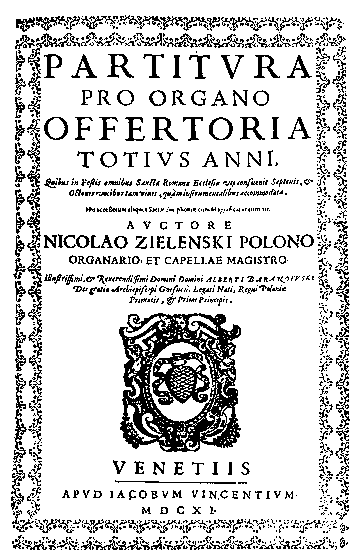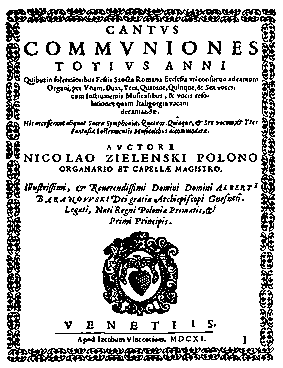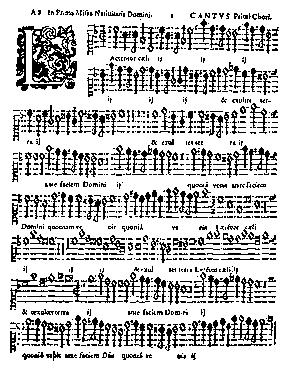|
POLISH EARLY MVSIC |
Composers | Essays | Sources | Feedback | Editorial |
Mikołaj Zieleński (ca.1550 - post 1616)
The following notes come from a CD with Zieleński's music and were slightly altered for questions of language and style. I could not find their author, otherwise I would mention his/her name there.

"Little is known today about the life and work of Mikołaj Zieleński who lived at the turn of the 17th century, indeed too little considering the volume of his work and its historical significance. The fragmentary information we have about him today allows us to reconstruct solely a very fragmentary biographical sketch about this composer. The circumstances in which his exceptional talent was born are a matter of many hypotheses and conjectures. The music created thanks to his exceptional gift allowed Zieleński to take a place in the history of music by which he is even regarded as the best Polish composer before Chopin. Szymon Skorowolski, a historian contemporary to Zieleński, classified him as a member of a group of Polish composers who had been educated in Rome, "in media Roma exercitati". This is a reference of great significance as it locates the main source of his musical knowledge as a professional composer.
Although the time of his musical education is determined by this remark it makes it possible to come up with a hypothesis as to the range of the Italian music masters under whom he may have studied or whose music became familiar to him and indicates his possible connections within Italian musical circles. It is quite certain that Zieleński studied the work of Palestrina whose compositions were recognized by the Council of Trent as the stylistic paragon and pattern of church polyphony. He also became familiar with the compositions of the Gabrielis (Andrea and his nephew Giovanni), the two most eminent representatives of the Venetian polychoral school. Likewise it cannot be excluded that the Polish composer acquainted himself with the ideas of Florentine camerata contained in Dialogo della musica antica et della moderna of V. Galilea (1581). Even the first attempts at accompanied monody made by Caccini and Galilea in their Le nuove musiche (1601) may have been familiar to him.
All the above-made suppositions and conclusions seem to find corroboration in the two volumes of works by Mikołaj Zieleński, Offertoria and Communiones (published in Venice in 1611) at the press of Jacob Vincentius. Both the frontispiece and the short preface published in these books state that Zieleński was a composer, organist and Kapelmeister at the court of the Polish primate Wojciech Baranowski. The status of the patron as well as the seat of his court, ?owicz, the capital of the Archbishops and Primates of Poland, and a well-known centre of musical life back in these days, were fitting with the composer's rank as a musician.
Unfortunately, these are the only known facts concerning the life and work of Mikołaj Zieleński. We know much more about his mastery as a composer from his works that were published.
Offertoria totius anni which make up the first volume, contain 56 seven- and eight-voiced compositions enriched with the accompaniment of instruments. Next to the Offertoria known surely after Gabrielli's Sacrae Simphoniae we find here a twelve voice Magnificat. The pieces in this collection are rendered in the concerto style of the polychoral Venetian school. Let us emphasize that the eight-voiced texture became the most typical form of this type of composition in the beginning of the 17th century. By taking up this trend, Zieleński became one of the precursors of the innovational approach to composing offertories.
 Communiones totius anni is composed of 57 (63? - A.J.) pieces differing as well in the number of parts (from one to six) and also in the required setup for performance. The majority among these works are motets in concerto style transposed in nota contra notam and often alluding to the classical style of Palestrina. A considerable group of pieces consists of tercets, duets and accompanied monody. The application of the monodic and concertante styles in the Communiones testifies to the innovative character of Mikołaj Zieleński as a composer."e;
Communiones totius anni is composed of 57 (63? - A.J.) pieces differing as well in the number of parts (from one to six) and also in the required setup for performance. The majority among these works are motets in concerto style transposed in nota contra notam and often alluding to the classical style of Palestrina. A considerable group of pieces consists of tercets, duets and accompanied monody. The application of the monodic and concertante styles in the Communiones testifies to the innovative character of Mikołaj Zieleński as a composer."e;
Here are some samples from the Communiones:
"Ziele?ski supplemented his Communiones... with three instrumental fantasies for the cornet, bassoon with the organ or for the violin and the viola with the organ. Yet the texture of the fantasias differs little from his vocal pieces. The second fantasia resembles a ricercar in its form while the third fantasia. mainly homophonic, more resembles a canzona. The Magnificat, which closes the cycle of the Offertoria, is a composition most elaborate in its form, texture and style of performance. It was composed for twelve parts in three choirs. The mastery of polychoral style which this piece clearly exhibits brought to Mikołaj Ziele?ski the reputation of The most perfect Venetian in Poland."
Sequencing, arrangement and comments to the following MIDI files © Michał Małecki.
Domus mea Communione in festo Dedicationis Ecclesiae [V, 29]
Domus mea, domus orationis vocabitur, dicit Dominus: in ea omnis, qui petit, accepit; et qui quaerit, invenit; et pulsanti aperietur in ea omnis; qui quaerit, invenit; et pulsanti aperietur.
Communion for the Feast of the Dedication of the Church
My house shall be called the House of Prayer - says the Lord: In it, everyone, who asks, receives, he who seeks, finds; and to him who knocks, the doors will be opened. In it, everyone, who asks, receives, he who seeks, finds; and to him who knocks, the doors will be opened.
This four-part communion with organo is written in a very typical late-Venetian style. Its melodic and harmonic aspects as well as the way of part-writing clearly show the new taste and aesthetics in composition. Composed as a kind of motetto, from the formal point of view it is divided in two parts, filling the scheme A-B-B'. The first part is rather polyphonic, with independent parts greatly embellished by the use of giorgia technique. The second employs two "sub-choruses": high and low, singing in dialogue with each other - a typical solution in that kind of music. The melodics here is also embellished, but it sounds much more baroque than before. Also in a few cases the musical composition directly reflects the meaning of the words being sung [e.g. et pulsanti - the short-value notes in ascending and descending diatonic 'a due' passages imitate the sound of knocking on the door]. The latter part is repeated once again with a changed ending. I've instrumented this Communio despite of the composer's advice [soli debent cantare cum organo sine instrumenti] using a consort of recorders with Bassus part reinforced by dulcian [here - bassoon]. The partitura pro organo [maintained here without reducing the embellishments, though in a little different form if compared to the source] is realized on a harpsichord for better clarity of sound.
 Viderunt omnes fines Terrae Communione in Festo ...
Viderunt omnes fines Terrae Communione in Festo ...
Viderunt omnes fines terrae salutare Dei nostri, Alleluia!
"Viderunt omnes" is a Christmas motet in four-parts. Its texture is, except for the Alleluia section, dense and generally polyphonic, which is rather a Renaissance than a Baroque approach. This version is a good example of a virtuoso compositon - its first section [Viderunt omnes fines terrae] contains a lot of giorgia embellishments - this amount and character of diatonic passages makes a performance extraordinarly difficult about maintaining an appropriate tempo. In general, the question of choosing apropriate tempi and proportions between the various tempi is not an easy one for the piece in question. The whole motet [except for the first part of Alleuia] is in tempus imperfectum [something like 2/2] with no change of mensura between the Viderunt omnes... section filled with giorgias and the much simpler section salutare Dei... almost without any added embellishment. In case of this virtuoso version, it could seem not to be a problem: Despite of a slow motion of long-valued notes, giorgias give the impression of a relatively fast tempo. But the simplified version for chorus and instruments has no embellishements, and its mensural indications remain unchanged. It is a well-known practice to apply a diminution [shortening all the note values by half] with no indication in the score, but I can't really find out, if it was done in this case. Again there is the same problem with the above-mentioned first section of Alleluia. It is in tempus perfectum diminutum [simplifying 3/4], but this time that diminution ratio [division by half] indicated in the score seems to be enough only in the virtuoso version. In the other one it should be twice as big as indicated, i.e. the original note values should be divided by four, or in other words in proportio quadrupla. Despite of all these open questions I've decided to use one single pulse of semibreves throughout the whole composition and a relatively fast tempo in general - I hope the result will meet historical performing practices. The Christmas melody should sound joyfully, shouldn't it? In scoring and instrumentation I cannot override the composer's intentions, however - therefore the vocal parts are played on a harpsichord, and the partitura pro organo on a positif organ 4' [here it is a GM whistle played an octave higher].
Magna est gloria Eius Communione in Festo Sanctum Mattheum
Magna est gloria Eius in salutari Tuo, gloriam et magnum decorem super eum, Domine.
Communione for the Feast of Saint Matheo.
This communion is composed in the form of a single-choir motetto from San Marco, Venice. A lot of compositions of that type were created during the XVIth century by Maestri di Capellae of that famous church. Despite of the one-choir scoring, the significant influence of Venetian polychoral technique is to be noticed here. Nevertheless, I've decided to use two "b.c." instruments, one per choir involved [the harpsichord for the recorder consort, and the organo 2' for the sackbutt consort] doubling the parts, despite of the use of a "general" organ playing the partitura pro organo in the center. Thanks to that it becomes possible to reveal the chori spezatti effect, which would otherwise be difficult to distinguish, especially, when that communio is sung in a typical concert. Here, again, the technique of dialoguing choruses is employed, and moreover, the technique of regrouping the voices [at the words magna est, for example], which results in a very interesting, organ-like effect of changing registers. The formal model consists of several sections employing different treatment of the parts: polyphon or homophon, with a division into two "subchoruses" or without, with the domination of some voices or else with equal treatment of them. This kind of construction shows perhaps most of the technical possibilities of expression to be encountered in pieces of such a type. This is the first version of that communio, intended for solists and organo, according to the advice of the composer "soli debent cantare cum organo sine instrumenti". Obviously, there is a second version of that communio, without all these incredibly sounding giorgia embellishments. As mentioned above, in scoring I've used two consorts [recorder and sackbutt], each with its own "continuo" instrument, harpsichord and organo 2' respectively. They are panned to achieve the best antiphonal effect of chori spezatti. The main partitura pro organo is played by an organ 4', but it is provided rather as a piano reduction of the whole score and could be muted during playback.